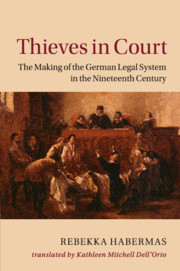Book contents
- Frontmatter
- Dedication
- Contents
- Acknowledgments
- Introduction: Questions Regarding Thieves, Reformers, Jurists, and Others
- PART I WHAT IS THEFT: QUESTIONS REGARDING THIEVES AND JURISTS – QUESTIONS REGARDING HONOR AND PROPERTY
- PART II HOW LAW IS MADE: EVIDENCE PRODUCTION
- 4 Techniques for Finding Truth – the Slow Production of the Modern State of Law
- 5 Techniques for Finding Truth and Other Types of Knowledge Formation: How Can a New Outlook Be Put into Practice?
- 6 Techniques for Finding Truth: How Do People Become Jurists and How Does Property Come into Being?
- PART III IN THE COURTROOM, OR WHAT IS LAW?
- Conclusion: The Making of the Modern Legal System – Thieves and Property
- Relevant Laws
- Bibliography
- Index
5 - Techniques for Finding Truth and Other Types of Knowledge Formation: How Can a New Outlook Be Put into Practice?
from PART II - HOW LAW IS MADE: EVIDENCE PRODUCTION
Published online by Cambridge University Press: 18 November 2016
- Frontmatter
- Dedication
- Contents
- Acknowledgments
- Introduction: Questions Regarding Thieves, Reformers, Jurists, and Others
- PART I WHAT IS THEFT: QUESTIONS REGARDING THIEVES AND JURISTS – QUESTIONS REGARDING HONOR AND PROPERTY
- PART II HOW LAW IS MADE: EVIDENCE PRODUCTION
- 4 Techniques for Finding Truth – the Slow Production of the Modern State of Law
- 5 Techniques for Finding Truth and Other Types of Knowledge Formation: How Can a New Outlook Be Put into Practice?
- 6 Techniques for Finding Truth: How Do People Become Jurists and How Does Property Come into Being?
- PART III IN THE COURTROOM, OR WHAT IS LAW?
- Conclusion: The Making of the Modern Legal System – Thieves and Property
- Relevant Laws
- Bibliography
- Index
Summary
How did the jurists and gendarmes know how certificates of character, lookout descriptions, visual inspection reports, and crime scene sketches should be produced? How did they know the techniques that ultimately lent these documents the character of proof? From the codes on criminal procedure issued before or after 1848, nothing can be gleaned on how a crime scene sketch should be prepared to give it the character of evidence. Nor is there a single word about how the significance of a visual inspection report is to be assessed. To learn more about the preparation but also the assessment of these types of evidence and thus about the techniques used in the preliminary investigation to decide what is “true” and “untrue,” it is necessary to look beyond regulations and textbooks. The answers are to be found in the new fields of knowledge emerging with increasing clarity at mid-century: statistics, jurisprudence, and criminology. These fields concerned themselves with questions similar to those in the preliminary investigation, that is, how can the truth about criminals and their actions be revealed, and what are especially good, that is to say objective, methods for finding truth? The questions were answered in an already familiar manner; here, too, desubjectification, decontextualization, and quantification procedures played an important role. As was already maintained earlier and is to be shown in the following pages, the way in which evidence is produced in the process of establishing justice calls to mind forms of knowledge production typical for a number of sciences that were emerging in the nineteenth century and that (also) dealt with the question of crime. Statistical logic, legal debates, criminological deduction, and court investigation practice went hand in hand and together created – as will become clear – a new image of the criminal as well as new criteria according to which “true” and “untrue” were distinguished from one another.
STATISTICS AND PRODUCTION OF THE MASS BEING
Statistics as a science had already become established in the eighteenth century but not until around the middle of the nineteenth century did it begin to spark broad interest on the part of the state and the public, which quickly formed statistical associations. Only at this point was a so-called Statistics Bureau created; its most important function was to examine the new administrative offices statistically.
- Type
- Chapter
- Information
- Thieves in CourtThe Making of the German Legal System in the Nineteenth Century, pp. 127 - 154Publisher: Cambridge University PressPrint publication year: 2016



